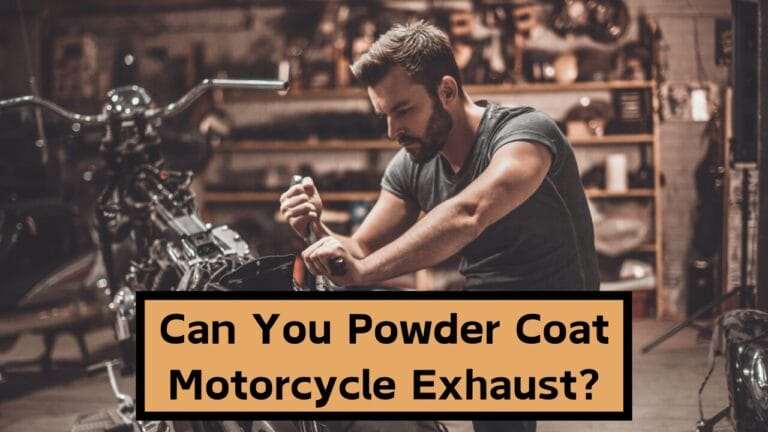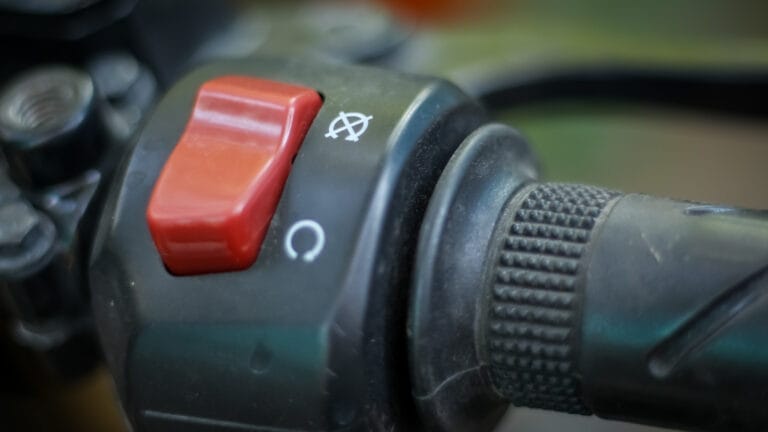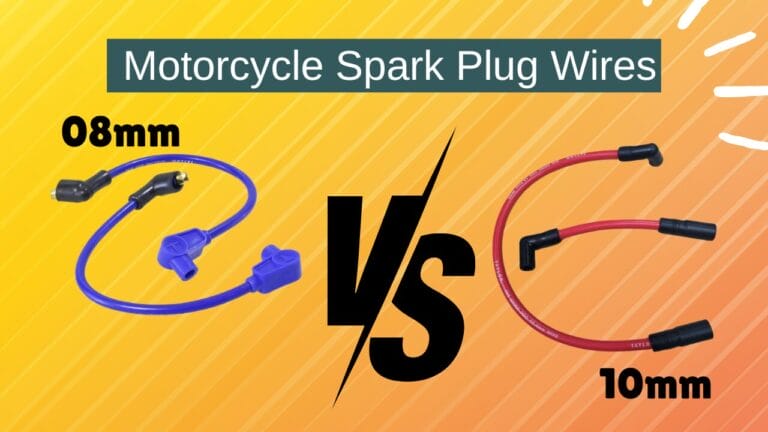Top Motorcycle Modifications for Improved Performance
If you’re a motorcycle enthusiast, chances are you’ve thought about ways to boost your bike’s performance. Whether you’re aiming for faster acceleration, smoother handling, or more power, the right modifications can completely transform your riding experience.
But with so many options available, where should you start? Should you upgrade your exhaust for a deeper growl, or is tweaking the suspension the key to better cornering?
In this guide, we’ll walk you through the top motorcycle modifications that can take your ride to the next level. From simple DIY upgrades to more advanced tweaks, we’ve got something for every rider.
Ready to maximize your bike’s potential? Let’s dive into the best performance mods you can make!
- Performance Exhaust Systems
- Air Filter Upgrades: Unlocking Your Motorcycle’s Potential
- ECU Tuning/Remapping: Optimize Your Motorcycle’s Performance
- Suspension Upgrades: Enhance Handling and Comfort
- Brake System Upgrades: Elevate Safety and Performance
- Lightweight Wheels and Tires: Unleash Your Bike’s Potential
- Upgrading to a High-Performance Chain and Sprocket Kit
- Engine Modifications: Cams, Pistons, and Bore Kits
- Weight Reduction Modifications
- Tires with Better Grip for Enhanced Performance
- Nitrous Oxide Kits: Unleashing Your Motorcycle’s Potential
- Final Words
Performance Exhaust Systems
A performance exhaust enhances engine efficiency, increases horsepower, and provides that iconic growl every rider loves. Whether you’re looking for more power or a lighter setup, the right exhaust can elevate your riding experience, making each journey more thrilling.
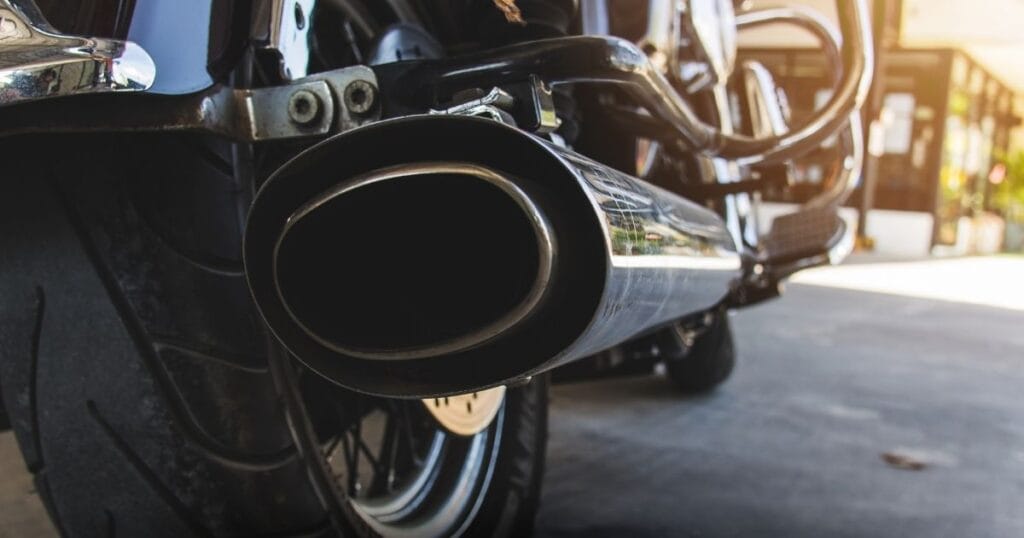
Key Benefits
- Increased Exhaust Flow: Larger diameter pipes and optimized bends reduce restrictions, improving exhaust flow and potentially increasing horsepower by 5-10%.
- Enhanced Combustion Efficiency: Improved scavenging of spent gases promotes more complete combustion, increasing power output and fuel efficiency.
- Improved Throttle Response: Reduced backpressure leads to quicker throttle response and faster acceleration.
- Weight Reduction: Lightweight materials like titanium or carbon fiber reduce overall bike weight, enhancing power-to-weight ratio and handling.
- Tuned Power Band: Performance exhausts optimize power delivery at specific RPM ranges, improving performance, especially in sport and racing scenarios.
- Aggressive Sound Profile: Upgraded exhaust systems provide a deeper, more aggressive sound, enhancing the riding experience.
Installation Considerations:
Installing a performance exhaust is often simple, as many systems are designed for direct bolt-on replacement. However, after installation, adjusting the bike’s fuel mapping is essential to match the new exhaust setup, as improper tuning may lead to suboptimal performance or even engine damage.
Price Overview
Prices vary based on material and brand, with quality stainless steel systems typically ranging from $400 to $800 and titanium or carbon fiber options exceeding $1,000. If professional installation is desired, expect additional costs of $100 to $300.
Air Filter Upgrades: Unlocking Your Motorcycle’s Potential
Stock filters often restrict airflow, limiting your engine’s potential. By switching to a high-performance air filter, you can improve engine efficiency, leading to better combustion and increased power.

Key Benefits
- Enhanced Airflow Dynamics: Performance air filters offer larger surface areas and less restrictive materials, improving airflow and increasing engine power by up to 10%.
- Efficient Filtration & Engine Longevity: Superior filtration materials like foam or cotton trap finer particles, reducing engine wear and improving efficiency.
- Responsive Throttle Performance: Better airflow leads to quicker engine response and smoother power delivery, enhancing the riding experience.
- Optimal Air-Fuel Mixture & Tuning: Adjusting fuel delivery and tuning the ECU ensures the optimal air-fuel mixture for maximum performance.
- Impact on Power Band & Acceleration: Improved airflow shifts the power band for better performance at different RPMs, especially during acceleration.
How often should I replace my air filter?
If you have a washable filter, clean it according to the manufacturer’s instructions. Non-reusable filters should be replaced every 10,000 to 15,000 miles.
Installation Consideartion:
Installing a high-performance air filter is generally simple and can be done in under 30 minutes. Many riders can handle the installation themselves with basic tools, as it usually involves removing the stock filter and replacing it with the aftermarket one. For those not comfortable with DIY, a professional mechanic can easily install it, often at a low labor cost.
Pricing Overview:
The cost of performance air filters typically ranges from $50 to $150 depending on the brand and material. Premium filters made from high-quality materials (like cotton or foam) may be priced higher but offer better filtration and durability.
ECU Tuning/Remapping: Optimize Your Motorcycle’s Performance
ECU tuning, or remapping, is a powerful modification that can significantly boost your motorcycle’s performance. The Engine Control Unit (ECU) is essentially the brain of your bike, controlling fuel injection, ignition timing, and other vital parameters. By optimizing these settings, you can unlock more power, enhance throttle response, and improve fuel efficiency.
Types of ECU Tuning
- Flash Tuning: This involves reprogramming the ECU with a custom map using specialized software.
- Piggyback Systems: These devices modify signals for fuel injection and ignition timing without altering the original ECU software.
- Standalone ECUs: A complete replacement for the stock ECU, offering maximum customization but requiring more complex installation.
Key Benefits of ECU Tuning
- Improved Fuel Efficiency: ECU tuning optimizes fuel mapping, increasing horsepower and torque by 5% to 15%, especially when paired with other mods.
- Enhanced Throttle Response: Tuning recalibrates throttle mapping for snappier acceleration and improved handling in various riding scenarios.
- Customizable Engine Mapping: Tailor the engine’s performance for different riding conditions, such as street, track, or off-road.
- Increased Rev Limiter: Adjusting the rev limiter allows the engine to reach higher RPMs, unlocking additional power for sport bikes.
- Broadened Power Band: Tuning expands the power band, providing smoother acceleration across the RPM range.
Installation Consideration:
ECU tuning is relatively simple, often involving a plug-and-play device or software update. However, professional installation is recommended for precise adjustments and optimal performance. Ensure the tuner is compatible with your bike’s make and model for the best results.
Pricing Overview:
ECU tuning typically ranges from $200 to $800, depending on the bike and the type of tuning software. Additional costs may include dyno testing or professional installation, which can increase the overall price.
Suspension Upgrades: Enhance Handling and Comfort
Investing in suspension upgrades can transform your motorcycle’s performance and overall riding experience. Whether you’re a casual rider or a performance enthusiast, a well-tuned suspension system boosts stability, traction, and comfort, enabling you to tackle various riding conditions with confidence.
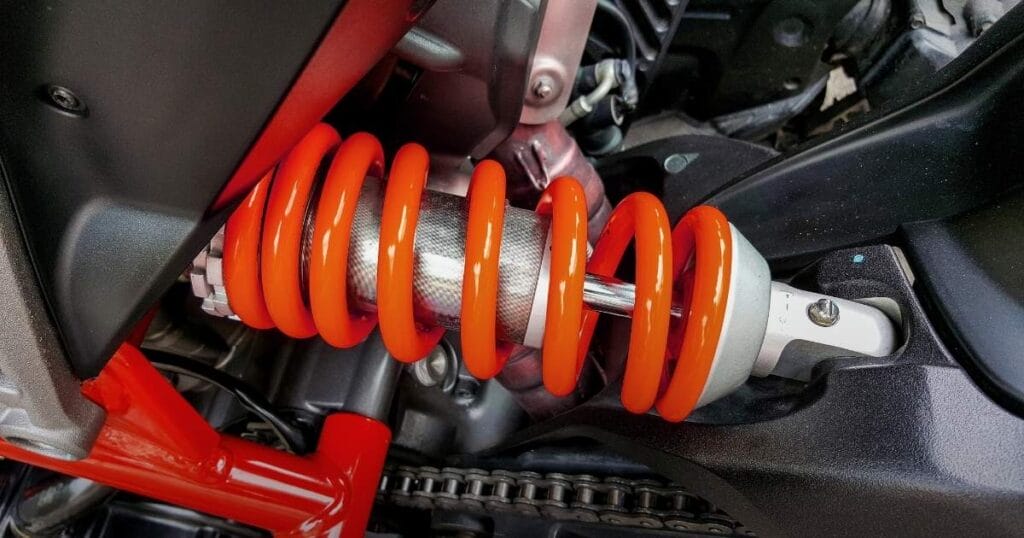
Types of Suspension Upgrades
Fork Upgrades: Upgrading the front forks can involve replacing the entire assembly or modifying internal components like springs and damping. Options include:
- Aftermarket Forks: Replace stock forks with high-performance models designed for improved damping and adjustability.
- Fork Springs: Swapping out stock springs for ones tailored to your weight and riding style can significantly enhance performance.
Rear Shock Upgrades: The rear shock is critical for stability and comfort. Upgrading can involve:
- Aftermarket Shocks: Install a premium shock absorber that offers better adjustability and damping capabilities.
- Preload Adjustments: Some shocks allow for preload adjustments, helping you set the right sag based on your weight and riding style.
Complete Suspension Kits: For those seeking a comprehensive solution, complete suspension kits provide matched front and rear components designed to work in harmony, typically delivering the best performance improvements.
Key Benefits of Suspension Upgrades
- Enhanced Handling and Stability: Higher-quality suspension components, such as adjustable forks and shock absorbers, allows for better handling during cornering and braking. Improved dampening and spring rates provide greater stability, helping the rider maintain control even at high speeds or on uneven surfaces.
- Improved Traction: A better suspension setup keeps the tires in contact with the road, maximizing grip and traction. This enables more aggressive cornering and acceleration while minimizing tire slip.
- Customizability for Riding Style: Many aftermarket suspension systems offer adjustable features, including preload, compression, and rebound settings. This allows riders to tailor their suspension setup to their specific riding style—be it touring, sport riding, or off-road adventures.
- Improved Braking Performance: A well-tuned suspension system maintain proper weight distribution during deceleration and prevents excessive front-end dive. This results more effective stopping power and increased rider confidence.
- Longer Tire Life: Proper suspension settings reduce excessive tire wear by ensuring even pressure distribution across the contact patch, leading to better grip and extending the life of your tires.
- Enhanced Cornering Ability: With an improved suspension, you can achieve better lean angles and cornering performance.
Installation Consideration
Installing suspension upgrades can vary in complexity depending on the type of upgrade. Fork and shock replacements are often simple for riders with basic mechanical skills, but some adjustments may require professional help.
Pricing Overview
- Prices can range significantly based on the components chosen. Basic fork or shock replacements can start at around $300.
- High-performance suspension kits may range from $1,000 to $2,500 or more, depending on brand and features.
Brake System Upgrades: Elevate Safety and Performance
Upgrading your motorcycle’s brake system is one of the most impactful modifications you can make to enhance safety and performance. While stock brakes are designed to meet basic needs, they often fall short in high-performance situations. A well-equipped braking system can transform your riding experience, allowing for greater control, responsiveness, and safety on the road.
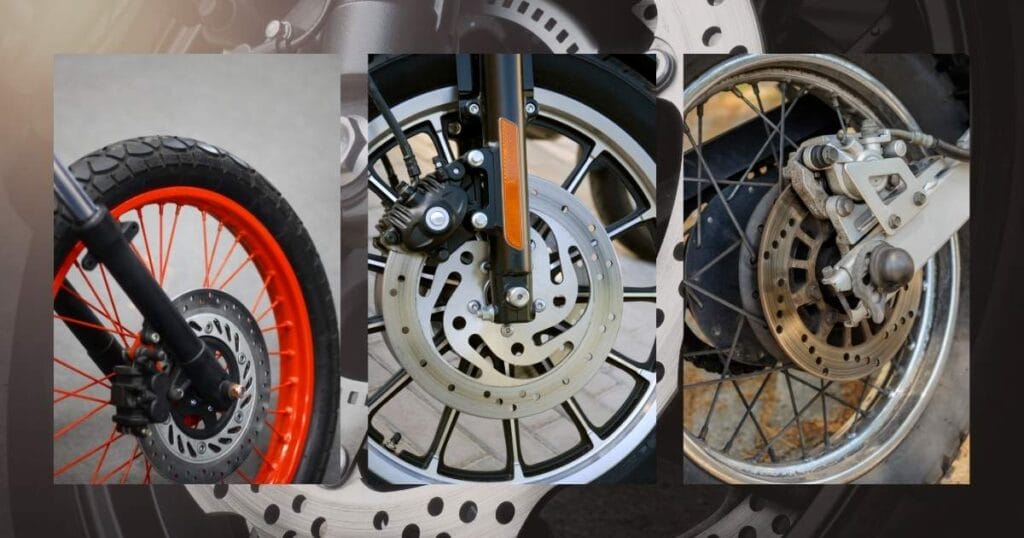
Types of Brake System Upgrades
Brake Pads:
High-friction brake pads provide better stopping power and reduce fade during aggressive riding. Options like sintered or ceramic pads can offer significant performance boosts.
Brake Rotors:
Installing larger or vented rotors improves heat dissipation, reducing brake fade during extended use. Lightweight materials can also reduce unsprung weight, enhancing overall handling.
Calipers:
Multiple piston calipers increase clamping force, and allow for more effective braking. This upgrade often leads to shorter stopping distances and improved feel at the lever.
Brake Lines:
Replacing stock rubber brake lines with braided stainless steel lines enhances brake feel and responsiveness by reducing flex under pressure.
Key Benefits of Brake System Upgrades
- Some riders have reported a 20% drop in stopping distance after upgrading their brake pads and rotors.
- Better parts can handle heat better, so your bike will always work well, even when you are riding hard or going down long descents.
- Riders can apply the brakes with precision, enhancing overall handling during cornering or emergency stops.
- Quicker and more effective stops can be the difference in avoiding potential accidents. directly contributes to rider safety
- Properly functioning brakes distribute braking forces evenly across the contact patch and reduces uneven tire wear. This extends the tire life and maintains grip.
Installation Consideration
Many riders choose DIY installation for brake pad and line replacements, as the process is relatively simple with basic tools and mechanical knowledge. However, for more complex upgrades or if you’re unsure about any part of the installation, professional help is recommended. A qualified mechanic can ensure proper installation, optimizing both performance and safety.
Pricing overview
Prices for brake system upgrades can vary widely:
- Brake pads typically range from $50 to $150.
- High-performance rotors can range from $100 to $400 each, depending on the design and brand.
- Complete brake kits may cost between $300 to $1,200.
Lightweight Wheels and Tires: Unleash Your Bike’s Potential
If you’re looking to take your motorcycle’s performance to the next level, upgrading to lightweight wheels and tires is a game-changer. This modification can dramatically enhance acceleration, handling, and overall ride quality, making your bike more responsive and fun to ride.
Why Go Lightweight?
Reduced Rotational Mass
Lighter wheels significantly reduce the rotational mass, meaning there’s less weight to spin up. This results in quicker acceleration and enhanced responsiveness. Adding lightweight wheels is a good idea for speed fans because studies show that lowering the weight of wheels by as little as 1 kg can speed up performance motorcycles by 0.1 seconds.
Improved Handling
Lightweight wheels enhance your motorcycle’s suspension response, leading to sharper cornering and a more agile ride. Performance experts suggest that they can boost handling by up to 30% on twisty roads, empowering you to conquer sharp turns and challenging terrains with confidence.
Better Ride Quality
Reducing unsprung weight improves ride comfort significantly. Lightweight wheels help your bike absorb road imperfections better, resulting in a smoother ride. Many riders experience less fatigue on long journeys due to enhanced suspension response that mitigates bumps and vibrations
Choosing the Right Materials
Aluminum Wheels
Aluminum wheels are solid balance of weight, strength, and affordability. Typically weighing between 5 to 7 lbs per wheel, they are an excellent option for everyday riders and performance enthusiasts alike.
Magnesium Wheels
Magnesium wheels are renowned for their exceptional strength-to-weight ratio, typically weighing around 3 to 5 lbs per wheel. While they provide significant performance benefits, they often come with a higher price tag and require more care to prevent corrosion. The investment in magnesium wheels can yield a 5-10% improvement in overall performance, making them appealing for competitive riders.
Carbon Fiber Wheels
As the priciest option, carbon fiber wheels typically weigh around 2 to 4 lbs per wheel and offer unparalleled performance enhancements. Their lightweight nature and stiffness contribute to superior handling and acceleration. However, their fragility and higher cost mean they may not be suitable for all riders, often being favored by those who prioritize performance above all else.
Types of Wheel and Tire Modifications
Lightweight Wheels
Switching to lightweight wheels can significantly reduce unsprung weight. For every 1 pound (0.45 kg) of unsprung weight you eliminate, you can potentially improve acceleration by 1 to 2 pounds (0.45 to 0.91 kg) of equivalent performance. This is because lighter wheels allow the suspension to react more quickly to road imperfections, improving handling and comfort.
Wider Tires
Wider tires increase the contact patch with the road, enhancing grip. Studies show that increasing the tire width by just 10 mm can improve grip by approximately 5-10% under ideal conditions, translating to more confidence in cornering and wet weather performance.
Performance Tires
Upgrading to high-performance tires can reduce lap times by 1-2 seconds per lap on a racetrack. These tires often feature advanced rubber compounds and tread patterns designed for optimal grip and responsiveness, resulting in better cornering and braking performance.
Tire Pressure Monitoring Systems (TPMS)
Maintaining optimal tire pressure is critical for performance. A study by the National Highway Traffic Safety Administration (NHTSA) found that under-inflated tires can reduce fuel efficiency by 0.2% for every 1 psi drop in pressure. TPMS helps ensure tires are always properly inflated, enhancing safety and performance.
Tire Choices Matter
When upgrading your wheels, selecting the right tires is equally important. Here’s what to consider:
1. Performance Tires
Choose tires designed specifically for enhanced grip. Performance tires can improve traction and handling significantly, especially if you plan to push your bike’s limits in corners or during aggressive acceleration. Research indicates that switching to performance tires can enhance cornering grip by up to 20%, making them crucial for sport and touring riders.
2. Tubeless Designs
Opting for tubeless tires can save weight and provide peace of mind against flats. They allow for a more enjoyable riding experience by reducing the risk of sudden deflation and simplifying maintenance. Riders who switch to tubeless designs often report a 30% reduction in puncture-related issues, enhancing overall riding confidence.
Installation Considerations
While some experienced riders may choose to handle wheel installation themselves, it’s important to understand the necessary tools and techniques for proper fitment. If you’re uncertain, avoid DIY, as improper installation can lead to handling issues. A professional installation can save you from potential pitfalls and ensure everything is correctly aligned.
Pricing Overview
- Wheels: Expect to invest between $600 to $2,000 for a set of lightweight wheels, depending on material and brand. For example, aluminum wheels may cost around $600, while high-end carbon fiber options can reach up to $2,000.
- Tires: High-performance tires typically range from $100 to $300 each. For a complete upgrade, factor in the cost of four tires, totaling $400 to $1,200.
Upgrading to a High-Performance Chain and Sprocket Kit
If you’re looking to enhance your motorcycle’s acceleration and responsiveness, upgrading to a high-performance chain and sprocket kit can make a significant difference. This modification optimizes power transfer from the engine to the rear wheel, providing a more thrilling riding experience.
The Benefits of Upgrading
- Improved Acceleration: A lighter chain and appropriately sized sprockets reduce rotational mass, allowing your bike to accelerate more quickly.
- Enhanced Torque Delivery: By adjusting the sprocket ratio, you can tailor your bike’s power delivery, making it feel more responsive during acceleration.
- Increased Durability: High-performance kits often use premium materials and advanced designs that last longer than stock components, ensuring you get the most out of your investment.
Chain Types
- O-Ring Chains:
These chains use rubber O-rings between the links to retain lubrication and keep dirt out. They offer longevity and performance, making them a popular choice for street riders. - X-Ring Chains:
An upgrade from O-rings, X-ring chains provide even better sealing and reduced friction. They are ideal for performance enthusiasts seeking maximum efficiency and lifespan. - Lightweight Chains:
Made with lighter materials, these chains reduce overall weight without sacrificing strength, enhancing acceleration and handling.
Sprocket Materials
- Steel Sprockets:
Durable and cost-effective, steel sprockets are a common choice for riders looking for longevity and performance. - Aluminum Sprockets:
Lighter than steel, aluminum sprockets can improve acceleration but may wear out faster, making them better suited for racing or performance applications. - Titanium Sprockets:
Offering the ultimate in weight savings and strength, titanium sprockets come at a premium price but are worth considering for serious performance upgrades.
Choosing the Right Gear Ratio
Adjusting the gear ratio by changing the front or rear sprocket size can have a substantial impact on your bike’s performance:
Lowering the Sprocket Ratio (larger rear sprocket or smaller front sprocket) will improve acceleration but may reduce top speed.
Raising the Sprocket Ratio (smaller rear sprocket or larger front sprocket) can increase top speed but may result in slower acceleration.
Installation Considerations
- DIY Installation:
If you’re mechanically inclined, this upgrade can often be done at home with basic tools. Ensure you have a chain tool for proper adjustment and installation. - Professional Installation:
If you’re unsure about the process, having a professional install the kit ensures everything is properly aligned and adjusted for optimal performance.
Pricing Overview
- Chain Kits: Prices typically range from $150 to $400, depending on the type and brand.
- Sprocket Kits: Expect to spend around $50 to $200 for high-quality sprockets.
Engine Modifications: Cams, Pistons, and Bore Kits
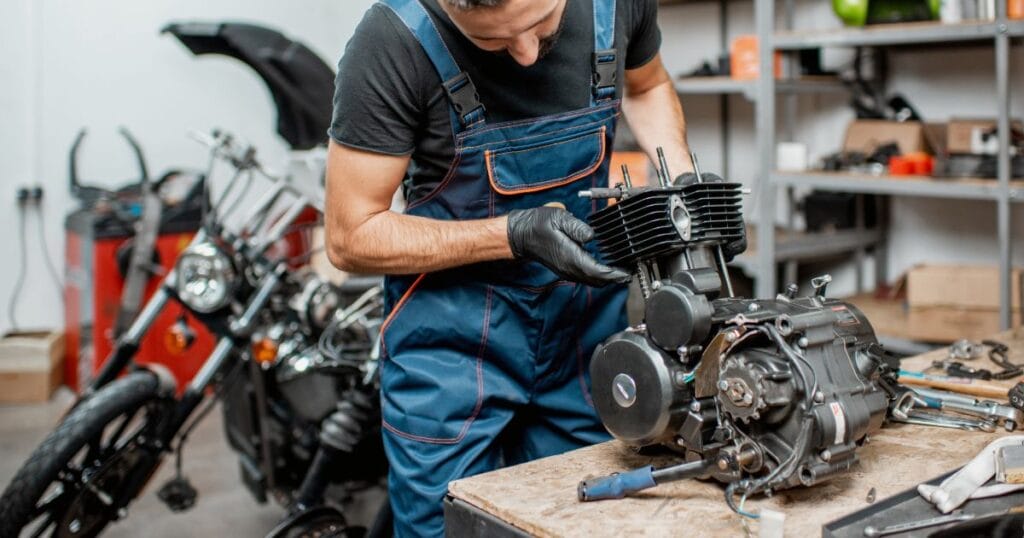
If you’re serious about boosting your motorcycle’s performance, engine modifications are key. Upgrading components like cams, pistons, and bore kits can dramatically enhance your bike’s power and responsiveness.
Engine modifications can significantly increase power output, delivering noticeable gains in horsepower and torque. This not only improves overall performance but also transforms your riding experience. Additionally, these upgrades enhance throttle response, allowing for quicker acceleration and a more dynamic, exhilarating ride.
Customizing your engine setup also means you can tailor the performance to your specific riding needs, whether you’re into street riding, long-distance touring, or high-speed track performance.
Performance Cams
Performance camshafts alter the timing and duration of the engine’s valve openings, enhancing airflow and combustion efficiency.
Key Benefits:
- Greater Lift and Duration: Performance cams can improve airflow into and out of the engine, allowing for more power at higher RPMs.
- Engine Character Changes: Different cam profiles can dramatically change the bike’s personality, offering a more aggressive feel and responsiveness.
- Compatibility with Other Mods: Upgrading cams often works best in conjunction with other performance modifications, such as exhaust and intake upgrades.
High-Compression Pistons
High-compression pistons increase the compression ratio within the engine, allowing for more efficient combustion and greater power output.
Key Benefits:
- More Power: Higher compression ratios can lead to noticeable gains in horsepower and torque.
- Improved Fuel Efficiency: A well-tuned high-compression engine can improve fuel efficiency by maximizing the energy extracted from each fuel molecule.
- Optimal Performance: High-compression pistons can be paired with premium fuels to achieve the best results.
Bore Kits
Bore kits involve enlarging the cylinder bore to increase engine displacement, resulting in a larger engine capacity and more power.
Key Benefits:
- Increased Displacement: By increasing the size of the cylinders, bore kits allow for more air and fuel mixture, resulting in greater power output.
- Enhanced Torque: A larger engine displacement can lead to improved torque across the RPM range, making your bike more responsive during acceleration.
- Potential for Further Upgrades: Bore kits can set the stage for additional engine modifications, including better exhaust systems and carburetion or fuel injection systems.
Installation Considerations
Engine modifications often need professional installation to ensure proper tuning and performance. You may also need additional upgrades, like better cooling or fuel systems, to support the enhanced power.
Pricing Overview
- Performance Cams: Prices can range from $300 to $1,000 depending on the brand and specifications.
- High-Compression Pistons: Expect to spend between $200 to $600 for a set of high-compression pistons.
- Bore Kits: Bore kits can vary significantly in price, typically ranging from $500 to $2,000, depending on the components included.
Weight Reduction Modifications
One of the most effective ways to enhance your motorcycle’s performance is through weight reduction. A lighter bike accelerates faster, handles better, and is generally more enjoyable to ride. By strategically reducing weight, you can significantly improve overall performance without compromising structural integrity.
Benefits of Weight Reduction
- Improved Acceleration: A lighter motorcycle requires less power to accelerate, leading to quicker take-offs and higher top speeds. For example, shedding just 10% of your bike’s weight can result in noticeable improvements in performance.
- Enhanced Handling: Reducing weight lowers the center of gravity, improving stability and maneuverability, especially in corners.
- Better Fuel Efficiency: Lighter bikes often consume less fuel, translating to longer rides between fill-ups.
Key Modifications for Weight Reduction
- Aftermarket Exhaust Systems: Upgrading to a performance exhaust made from lightweight materials like titanium or carbon fiber can reduce weight significantly—often by 10-20 pounds compared to stock systems.
- Aluminum or Carbon Fiber Parts: Replacing stock parts such as foot pegs, levers, and brackets with aluminum or carbon fiber components can shed pounds without sacrificing strength.
- Forged or Lightweight Alloy Wheels: Swapping out heavy stock wheels for forged or lightweight alloy options reduces rotational mass, enhancing acceleration and braking performance. A set of lightweight wheels can save 5-15 pounds.
- Lithium-Ion Batteries: Replacing a standard lead-acid battery with a lithium-ion battery can save several pounds. These batteries also provide better performance and longevity.
- Streamlining: Evaluate your bike for non-essential parts or accessories that can be removed, such as passenger footpegs, excess bodywork, or even the stock airbox if replaced with a performance air filter setup.
Installation Considerations
Many weight reduction modifications, like replacing exhausts or batteries, can be done by experienced DIYers, but more complex tasks, such as installing lightweight wheels, may require professional help for proper fit and safety. It’s important to ensure that any modifications don’t compromise your bike’s balance, structural integrity, or handling.
Pricing Overview
- Lightweight Exhaust Systems: Prices can range from $400 to $1,200, depending on material and brand.
- Lightweight Wheels: Expect to spend between $800 to $2,500 for a set of forged or lightweight alloy wheels.
- Lithium-Ion Batteries: Costs typically range from $150 to $400 for a good-quality lithium-ion battery.
Tires with Better Grip for Enhanced Performance
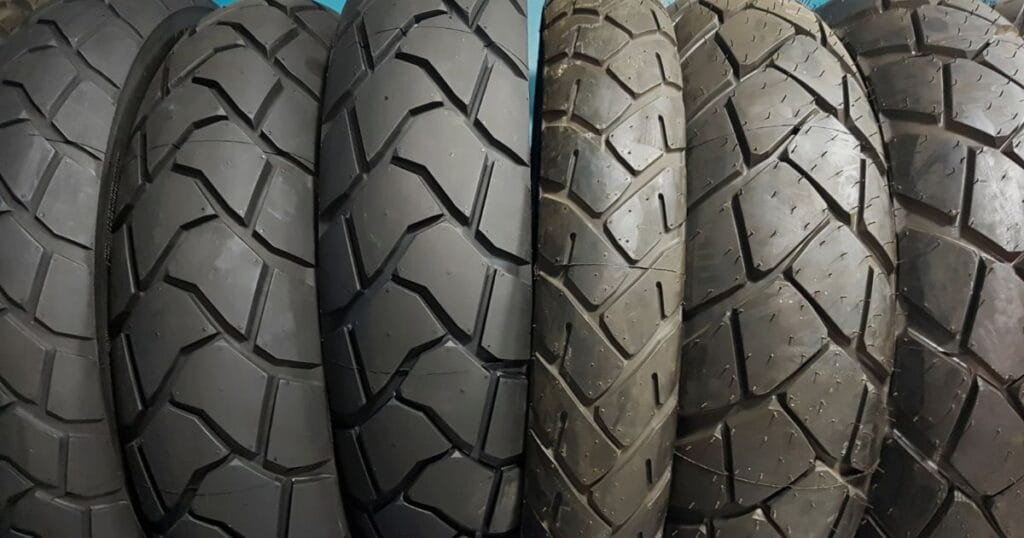
Upgrading to high-performance tires is one of the most impactful modifications you can make to your motorcycle. Tires are your bike’s sole point of contact with the road, and investing in the right set can significantly enhance traction, stability, and overall riding experience.
Benefits of Upgrading Tires
- Enhanced Traction: Performance tires are engineered with specialized rubber compounds and tread patterns that offer superior grip, particularly during cornering and braking. Studies show that riders using high-performance tires experience a 15-30% improvement in grip compared to standard tires.
- Improved Handling: Better grip translates to increased confidence in turns, allowing for faster cornering speeds and sharper handling. Riders often report feeling more connected to the road, which can lead to a more exhilarating ride.
- Increased Safety: High-quality tires provide superior feedback and control, reducing the likelihood of skidding or losing traction in wet or challenging conditions. According to the National Highway Traffic Safety Administration (NHTSA), approximately 30% of motorcycle accidents are due to tire-related issues, highlighting the importance of proper tire selection.
Key Features to Look For
Tread Design:
- Sport Tires: Designed for maximum grip on dry surfaces, sport tires typically feature shallower tread patterns that increase the contact patch, ensuring optimal performance during aggressive riding.
- Dual-Compound Tires: These tires incorporate two different rubber compounds—a harder compound in the center for durability and a softer one on the edges for improved cornering grip. This design maximizes performance while extending tire life.
Rubber Composition:
- Soft Compounds: Tires made from softer rubber compounds offer better grip but may wear out more quickly. These are ideal for spirited riding and track use, where performance is paramount.
- All-Weather Performance: Some tires are engineered to excel in both wet and dry conditions, providing balanced grip for various riding scenarios. For instance, tires like the Michelin Pilot Road series have been praised for their versatility in different weather conditions.
Tire Size:
- Wider Tires: Upgrading to wider tires can increase the contact patch with the road, enhancing grip and stability. However, ensure that the wider tires are compatible with your motorcycle’s specifications to avoid handling issues.
Installation Considerations
While experienced riders may change their own tires, professional installation is recommended to ensure proper mounting and balancing for optimal performance and safety. After installation, regular checks on tire pressure and tread wear are essential, as maintaining the correct tire pressure can improve fuel efficiency by up to 3% and enhance handling and safety.
Pricing Overview
Prices typically range from $150 to $400 per tire, depending on brand, type, and specifications. Premium brands may charge more but often provide better performance and durability, making them a worthwhile investment for serious rider
Nitrous Oxide Kits: Unleashing Your Motorcycle’s Potential
For riders seeking an exhilarating boost in performance, nitrous oxide (N2O) kits offer a game-changing modification. Popular among racers and performance enthusiasts, these systems can significantly enhance acceleration and speed, making every ride an adrenaline-fueled adventure.
How Nitrous Oxide Works
Nitrous oxide functions by injecting a high concentration of oxygen into the engine’s combustion chamber. This process enables more complete combustion of fuel, resulting in a powerful 20-50% increase in horsepower. Riders can experience an instant surge of power, making it ideal for straight-line acceleration and track use, without the need for permanent engine modifications.
Legal Considerations: Know Before You Go
While nitrous oxide systems can be thrilling, it’s important to understand the legal landscape. In many regions, using nitrous on public roads is illegal due to safety concerns and the potential for misuse. Always check local laws and regulations to ensure compliance and avoid legal pitfalls. When in doubt, save the nitrous for the track, where performance modifications are more widely accepted and regulated.
Installation and Safety: What You Need to Know
Professional Installation Recommended: Installing a nitrous oxide kit is complex and requires expertise. Improper installation can lead to engine damage or unsafe operation. A professional installer can ensure the system integrates seamlessly with your motorcycle’s fuel and ignition systems, maximizing performance while minimizing risk.
Safety Precautions:
- Engine Compatibility: Before installation, assess whether your engine can handle the increased power. You may need to upgrade components like the fuel system and clutch to ensure reliability and safety.
- Regular Monitoring: After installation, keep a close eye on engine performance. Look for any signs of stress or failure, and consider using nitrous sparingly to maintain engine integrity.
- Protective Gear: Always wear appropriate safety gear when using nitrous, especially on the track. This includes a full-face helmet, gloves, and protective clothing to safeguard against unexpected situations.
Real-World Impact: Riders’ Experiences
Many riders report that adding a nitrous kit not only enhances acceleration but also transforms their overall riding experience. For instance, racers have noted improved lap times and a more thrilling ride, while street riders appreciate the extra power when merging onto highways or overtaking.
Pricing Overview: What to Expect
Nitrous kits typically range from $500 to $1,500, depending on complexity and brand. Be sure to factor in additional costs for professional installation and any necessary tuning, which can add another $200 to $500 to your budget.
Final Words
In conclusion, upgrading your motorcycle for improved performance can transform your riding experience. From air filters to exhaust systems, each modification plays a vital role in enhancing power, handling, and efficiency. Whether you’re looking for a boost in speed, smoother rides, or better fuel economy, choosing the right upgrades will depend on your specific needs and riding style. Start with the basics, like tires or air filters, and gradually add more advanced mods as you go. With thoughtful choices, you can take your bike’s performance to the next level and enjoy the ride like never before!



